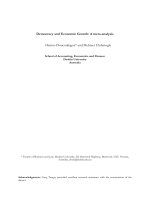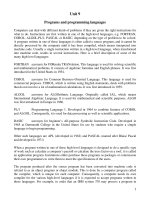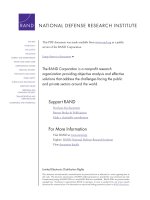Hedge Funds and Systemic Risk pdf
Bạn đang xem bản rút gọn của tài liệu. Xem và tải ngay bản đầy đủ của tài liệu tại đây (572.61 KB, 147 trang )
For More Information
Visit RAND at www.rand.org
Explore the RAND Corporation
View document details
Support RAND
Purchase this document
Browse Reports & Bookstore
Make a charitable contribution
Limited Electronic Distribution Rights
is document and trademark(s) contained herein are protected by law as indicated
in a notice appearing later in this work. is electronic representation of RAND
intellectual property is provided for non-commercial use only. Unauthorized posting
of RAND electronic documents to a non-RAND website is prohibited. RAND
electronic documents are protected under copyright law. Permission is required
from RAND to reproduce, or reuse in another form, any of our research documents
for commercial use. For information on reprint and linking permissions, please see
RAND Permissions.
Skip all front matter: Jump to Page 16
e RAND Corporation is a nonprot institution that
helps improve policy and decisionmaking through
research and analysis.
is electronic document was made available from
www.rand.org as a public service of the RAND
Corporation.
CHILDREN AND FAMILIES
EDUCATION AND THE ARTS
ENERGY AND ENVIRONMENT
HEALTH AND HEALTH CARE
INFRASTRUCTURE AND
TRANSPORTATION
INTERNATIONAL AFFAIRS
LAW AND BUSINESS
NATIONAL SECURITY
POPULATION AND AGING
PUBLIC SAFETY
SCIENCE AND TECHNOLOGY
TERRORISM AND
HOMELAND SECURITY
is product is part of the RAND Corporation monograph series.
RAND monographs present major research ndings that address the
challenges facing the public and private sectors. All RAND mono-
graphs undergo rigorous peer review to ensure high standards for
research quality and objectivity.
Lloyd Dixon, Noreen Clancy, Krishna B. Kumar
Hedge Funds and
Systemic Risk
C O R P O R A T I O N
The RAND Corporation is a nonprofit institution that helps improve
policy and decisionmaking through research and analysis. RAND’s
publications do not necessarily reflect the opinions of its research clients
and sponsors.
R
®
is a registered trademark.
© Copyright 2012 RAND Corporation
Permission is given to duplicate this document for personal use only, as
long as it is unaltered and complete. Copies may not be duplicated for
commercial purposes. Unauthorized posting of RAND documents to a
non-RAND website is prohibited. RAND documents are protected under
copyright law. For information on reprint and linking permissions, please
visit the RAND permissions page ( />permissions.html).
Published 2012 by the RAND Corporation
1776 Main Street, P.O. Box 2138, Santa Monica, CA 90407-2138
1200 South Hayes Street, Arlington, VA 22202-5050
4570 Fifth Avenue, Suite 600, Pittsburgh, PA 15213-2665
RAND URL:
To order RAND documents or to obtain additional information, contact
Distribution Services: Telephone: (310) 451-7002;
Fax: (310) 451-6915; Email:
Cover photo courtesy of Thinkstock/iStockphoto.
The research described in this report was supported by a contribution by
Christopher D. Petitt, principal of Blue Haystack, a financial research
and consulting firm, and by the RAND Center for Corporate Ethics and
Governance.
Library of Congress Control Number: 2012948078
ISBN 978-0-8330-7684-7
iii
Preface
Hedge funds are investment pools open to high-net-worth investors
and institutions but not to the general public. In part because of this
restriction, hedge funds have, until recently, been subject to reduced
reporting and oversight regulations. ey have also been reluctant to
provide even general information on their operations and strategies to
the public, fearing that such information could be construed as making
a public oering. e result has been very poor public understanding
of hedge funds and their role in the nancial system.
Like other participants in the nancial system, hedge funds
invested in many of the nancial instruments linked to the nancial
crisis of 2007–2008. As a consequence, their role in the nancial crisis
and potential contribution to systemic risk have drawn increased atten-
tion from Congress, regulators, participants in the nancial system, and
researchers. With the passage of the Dodd-Frank Wall Street Reform
and Consumer Protection Act of 2010 (Pub. L.111-203), regulations
are currently being developed that have the potential to signicantly
aect the hedge fund industry and its role in the nancial system.
To improve the general understanding of hedge funds, this report
provides an overview of the hedge fund industry, of hedge fund strat-
egies and operations, and of the role of hedge funds in the nancial
system. To better understand how hedge funds might contribute to
systemic risk, it investigates the role hedge funds played in the nancial
crisis and revisits the consequences of a large hedge fund’s failure in
the late 1990s. It also examines whether and how the ongoing nancial
reforms address the potential systemic risks posed by hedge funds.
iv Hedge Funds and Systemic Risk
is research was supported by a contribution by ChristopherD.
Petitt, principal of Blue Haystack, a nancial research and consulting
rm. It was also supported by the RAND Center for Corporate Ethics
and Governance. e report should be of interest to policymakers, reg-
ulators, members of the nancial community, and others interested in
improving the stability of the U.S. nancial system while maintaining
its dynamism and eciency.
The RAND Center for Corporate Ethics and Governance
e RAND Center for Corporate Ethics and Governance is commit-
ted to improving public understanding of corporate ethics, law, and
governance and to identifying specic ways in which businesses can
operate ethically, legally, and protably. e center’s work is supported
by voluntary contributions from private-sector organizations and indi-
viduals with interests in research on these topics.
For more information on the RAND Center for Corporate Ethics
and Governance, see or contact the director:
Michael Greenberg
Director, RAND Center for Corporate Ethics and Governance
4570 Fifth Avenue, Suite 600
Pittsburgh, PA 15213
412-683-2300 x4648
Questions or comments about the monograph should be sent to
the project lead:
Lloyd Dixon, Senior Economist
RAND Corporation
1776 Main Street, P.O. Box 2138
Santa Monica, CA 90407-2138
310-393-0411 x7480
v
Contents
Preface iii
Figures
ix
Tables
xi
Summary
xiii
Acknowledgments
xxvii
Abbreviations
xxix
CHAPTER ONE
Introduction 1
Potential Contribution of Hedge Funds to Systemic Risk
4
Research Methods
5
Organization of is Report
6
CHAPTER TWO
Background on the Hedge Fund Industry 9
Overview of the Hedge Fund Industry
9
Legal Structure and Role in the Financial System
9
Number of Hedge Funds and Assets Under Management
12
Restrictions on Investor Withdrawals from Hedge Funds
15
Characteristics of Hedge Fund Investors
16
Distribution of Funds in the Industry, by Size and Characteristics of
Hedge Fund Advisers
17
Hedge Fund Returns and Investment Strategies
21
Attributes of Hedge Funds at Amplify and Mitigate eir Potential
Contribution to Systemic Risk
28
vi Hedge Funds and Systemic Risk
CHAPTER THREE
e Collapse of Long-Term Capital Management 31
Factors Leading to the Collapse of Long-Term Capital Management
31
e Rescue of Long-Term Capital Management
33
e Aftermath of the Collapse of Long-Term Capital Management
34
Lessons from the Collapse of Long-Term Capital Management
37
CHAPTER FOUR
Hedge Funds and the Financial Crisis of 2007–2008 39
Factors Underlying the Financial Crisis
39
Hedge Fund Contribution to the Financial Crisis rough the Credit
Channel
41
Impact of Hedge Fund Losses on Creditors
41
e Failure of the Bear Stearns Hedge Funds
43
Hedge Fund Contribution to the Financial Crisis rough the Market
Channel
45
Hedge Fund Contribution to the Buildup of the Housing Bubble
45
Hedge Fund Deleveraging
50
Short Selling
55
Hedge Fund Runs on Investment Banks
59
Assessment of Hedge Fund Contributions to the Financial Crisis
61
CHAPTER FIVE
Potential Hedge Fund reats to Financial Stability and
Reforms to Address em
63
Potential Hedge Fund reats to Financial Stability
63
Lack of Information on Hedge Funds
63
Lack of Appropriate Margin in Derivatives Trades
64
Runs on Prime Brokers
64
Short Selling
65
Compromised Risk-Management Incentives
65
Lack of Portfolio Liquidity and Excessive Leverage
66
Financial Reforms at Address Hedge Fund Contributions to
Systemic Risk
68
Reforms at Address Lack of Information on Hedge Funds
68
Contents vii
Reforms at Address Lack of Appropriate Margin in Derivatives
Trades
74
Reforms at Address Hedge Fund Runs on Prime Brokers
77
Reforms at Address Short Selling
79
Reforms at Address Risk-Management Incentives
82
Reforms at Address the Liquidity and Leverage of Hedge Fund
Portfolios
86
Summary
96
CHAPTER SIX
Conclusion 99
APPENDIX
Regulatory Reforms at Address Potential Systemic Risks
Posed by Hedge Funds
103
References
107
ix
Figures
2.1. Number of Hedge Funds 13
2.2. Assets Under Management by the Hedge Fund Industry 13
2.3. Assets Under Management by the Hedge Fund Industry
Compared with Assets in Other Financial Sectors 14
2.4. Assets Managed by Funds of Funds as a Percentage of
Assets Managed by Hedge Funds
18
2.5. Distribution of Funds and Assets Under Management,
by Size of Fund
19
2.6. Annual Returns for the Hedge Fund Industry and the
S&P 500
22
4.1. Number of Hedge Fund Launches and Liquidations 42
4.2. Returns on Funds at Focus on Mortgage-Backed
Securities
48
4.3. Net Investor Inows into Funds Whose Primary Asset
Focus Is Fixed-Income Mortgages
49
4.4. Investor Flows by Primary Asset Class 51
xi
Tables
2.1. Percentage of Market Turnover Accounted for by Hedge
Funds
15
2.2. Largest Hedge Fund Advisers, by Assets Under
Management Worldwide, as of June 30, 2011
19
2.3. Distribution of Assets Under Management, by Primary
Asset Class
23
2.4. Distribution of Assets Under Management, by Directional
Bias of Portfolio
24
2.5. Distribution of Assets Under Management, by Primary
Investment Strategy 26
A.1. Regulatory Reforms at Address Potential Systemic
Risks Posed by Hedge Funds
103
xiii
Summary
Hedge funds are a dynamic part of the global nancial system. eir
managers engage in innovative investment strategies that can improve
the performance of nancial markets and facilitate the ow of capital
from savers to users. Although hedge funds play a useful role in the
nancial system, there is concern that they can contribute to nancial
instability. e collapse of Long-Term Capital Management (LTCM)
in 1998 raised awareness that hedge funds could be a source of risk to
the nancial system. Hedge funds also invested heavily in many of the
nancial instruments at the heart of the nancial crisis of 2007–2008,
and it is appropriate to ask whether they contributed to the crisis.
is report explores the extent to which hedge funds create or
contribute to systemic risk. By systemic risk, we mean the risk of a major
and rapid disruption in one or more of the core functions of the nan-
cial system caused by the initial failure of one or more nancial rms
or a segment of the nancial system. To do this, we explore the role
hedge funds played in the nancial crisis. We also examine the conse-
quences of the 1998 failure of LTCM, a large hedge fund. In addition,
we examine whether and how the recent nancial-reform legislation,
the Dodd-Frank Wall Street Reform and Consumer Protection Act of
2010, addresses the potential systemic risks posed by hedge funds.
xiv Hedge Funds and Systemic Risk
e analysis is based on review of relevant literature; interviews
with 45 people, including hedge fund managers, hedge fund law-
yers, investors, regulators, sta of industry associations, congressional
sta, researchers, and policy analysts; and analysis of data provided by
a leading rm that compiles statistics on hedge fund operations and
performance.
Overview of the Hedge Fund Industry
Generally speaking, hedge funds are investment pools that can solicit
funds from large institutions and wealthy investors but not from the
general public. As a result, they face fewer restrictions than funds
that are marketed to the general public, such as mutual funds. Unlike
mutual funds, hedge funds can use leverage without limit, can engage
in short sales,
1
can impose restrictions on investor withdrawals, are free
to pursue any investment strategy they choose, and are exempt from
many reporting and other regulatory oversight requirements. Salient
characteristics of the industry follow:
• e investor assets managed by the hedge fund industry (assets
under management, or AUM) have grown rapidly in the past
15years but are still not large compared with mutual funds (one-
tenth as large) or banks (one-sixth as large). Hedge funds do,
however, account for a substantial share of the trading volume in
many markets.
• e sources of hedge fund capital are diverse, with a least one-
third coming from pension funds, endowments, and foundations.
Hedge fund returns thus do not benet just wealthy individuals
but individuals across the economic spectrum.
• A sizable proportion of the AUM industry-wide is invested in
a relatively small percentage of funds: More than 70percent of
AUM is invested in less than 10percent of the approximately
1
A short seller essentially sells a security rst and buys it back later. Long investors do the
reverse.
Summary xv
10,000 funds worldwide.
2
at said, the industry is not consid-
ered concentrated according to standard measures of industry
concentration.
• Even though short sales are a central part of many hedge fund
investment strategies, hedge funds take both long and short posi-
tions. In fact, a much higher percentage of AUM is in funds that
invest only long or have a long bias than in funds with a short
bias.
Hedge funds can, in principle, contribute to systemic risk through
a credit channel and a market channel. Systemic risk can arise through
the credit channel when hedge fund losses result in default to credi-
tors and the nancial institutions with which they do business and
these losses go on to cause broader problems in the nancial system.
Systemic risk through the market channel can arise when hedge funds
drive unsustainable increases in asset prices during nancial booms or
contribute to price declines that overshoot long-run market equilib-
rium in nancial crises.
Hedge Fund Contributions to the Financial Crisis
Our assessment is that hedge funds were not a primary cause of the
nancial crisis, although some aspects of their operations contributed
to the crisis. e roles played by credit-rating agencies, mortgage lend-
ers, and inadequately backed credit default swaps (CDSs) were far more
important. In this section, we summarize our ndings on hedge fund
contributions through the credit and market channels.
Contributions to the Financial Crisis Through the Credit Channel
Hedge funds suered substantial losses during the nancial crisis,
and approximately 18 percent of funds (in number) were liquidated
in 2008.
3
However, there is little indication that hedge fund losses led
2
Data provided to the authors by eVestment|HFN.
3
Data provided to the authors by eVestment|HFN.
xvi Hedge Funds and Systemic Risk
to signicant losses at prime brokers and other creditors.
4
It appears
that prime brokers and other hedge fund creditors required adequate
margin and collateral to protect themselves against hedge fund losses.
Contributions to the Financial Crisis Through the Market Channel
Buildup of the Housing Bubble
Hedge funds were on both sides of the subprime-mortgage market. On
the one hand, hedge funds invested in the mortgage-backed securi-
ties (MBSs) and collateralized debt obligations (CDOs) that contrib-
uted to the buildup of the housing bubble. Conversely, by shorting
subprime mortgages and banks that were heavily exposed to subprime
debt, hedge funds called attention to the growing bubble. ey also
provided funds to this market at the trough of the crash, possibly lim-
iting further declines. In light of these opposing factors, no strong case
can be made that hedge funds were a signicant contributor to the
nancial crisis through the buildup of the housing bubble. Other fac-
tors, such as the behavior of credit-rating agencies, the availability of
inadequately backed CDSs, and careless lending practices appear to be
far more important.
Hedge Fund Deleveraging
In reaction to substantial losses in MBSs, Wall Street banks began to
reduce the credit available to some highly leveraged hedge funds in the
summer of 2008. At the same time, hedge funds faced unprecedented
withdrawals by their investors. ese forces created pressures on hedge
funds to sell assets during the peak of the nancial crisis, potentially
contributing to the rapid decline in asset prices. Rapid declines in asset
prices can create self-reinforcing cycles of margin calls, additional asset
liquidations, and further price declines.
e pernicious eects of deleveraging are magnied by lack of
liquidity and leverage. e evaporation of liquidity in many markets
during the nancial crisis caught many hedge fund managers by sur-
prise and demonstrates how assumptions about liquidity can quickly
4
A prime broker is an institution (or part of an institution) that oers various settlement,
custody, and nancing services to hedge funds and other specialized investment or dealing
operations.
Summary xvii
break down. Data are not available, however, to determine the extent
to which hedge funds were forced to sell in illiquid markets, further
deepening the nancial crisis.
Even though some hedge funds are highly leveraged, hedge fund
leverage does not stand out as a central contributor to the nancial
crisis. Hedge fund leverage started to decrease prior to the rst signs
of the nancial crisis in mid-2007, even as the leverage of investment
banks, commercial banks, and the nancial sector as a whole contin-
ued to increase. At the peak of the crisis in late 2008, investment banks
had the highest leverage.
No strong conclusions can be made about the extent to which
hedge fund deleveraging contributed to the nancial crisis. ere is
evidence that hedge funds contributed to downward price pressure and
withdrew liquidity in some markets, but it is hard to assess whether
the eects were substantial. What is more, investor inows into funds
that invest primarily in mortgage-related securities suggest that hedge
funds also injected liquidity into some markets.
Short Selling
Short selling is a central part of many hedge fund investment strate-
gies, and hedge fund shorting has been blamed for contributing to
the nancial crisis. e U.S. Securities and Exchange Commission’s
(SEC’s) ban on shorting nancial stocks between September 19 and
October 8, 2008, indicates that at least some in government were con-
cerned about the impact of short selling. Although some studies iden-
tify short selling as a signicant contributor to the nancial crisis, the
bulk of research does not conclude that short selling played a major
role. e banks’ nancial problems were much more directly related
to their exposure to toxic mortgage assets and investor realization of
the extent of this exposure than to the short selling of their stocks by
hedge funds.
xviii Hedge Funds and Systemic Risk
Hedge Fund Runs on Prime Brokers
During 2008, hedge fund managers withdrew tens of billions of dol-
lars in assets from prime brokers and their parent investment banks.
ese withdrawals were essentially a run on the bank, analogous to
bank runs by individual depositors during the Great Depression, and
contributed to the nancial crisis. Even though hedge fund withdraw-
als arguably weakened some prime brokers and their parent organiza-
tions, there were valid reasons for the withdrawals. Hedge funds were
concerned that their assets could be frozen if the banks that held them
declared bankruptcy. Such a worst-case scenario did indeed occur in
the September 2008 bankruptcy of Lehman Brothers Holdings.
Potential Contributions to Systemic Risk and Regulatory
Responses
Although hedge funds did not play a pivotal role in the nancial crisis,
examination of the crisis reveals ways in which they can potentially
contribute to systemic risk. Similarly, review of the LTCM episode illu-
minates potential threats to nancial-system stability. From our analy-
sis, we identify six areas of concern regarding hedge funds’ potential
contribution to systemic risk:
• lack of information on hedge funds
• lack of appropriate margin in derivatives trades
• runs on prime brokers
• short selling
• compromised risk-management incentives
• lack of portfolio liquidity and excessive leverage.
We also examine the extent to which Dodd-Frank and other recent
regulations allay these concerns.
Lack of Information on Hedge Funds
Following the LTCM collapse and during the nancial crisis, regula-
tors complained about the lack of transparency in hedge fund posi-
Summary xix
tions, leverage, and asset valuation and were frustrated by their inabil-
ity to collect data on hedge funds. Without such information, it is not
possible to identify building systemic risk in the hedge fund industry.
Dodd-Frank aggressively addresses gaps in the information avail-
able to regulators on hedge fund operations, investment strategies, and
investment positions.
5
e legislation will also result in far more infor-
mation being available on derivatives trades, trades that were at the
heart of the nancial crisis, and short sales. Although these provisions
are far reaching, limitations on the new information requirements
remain. Foreign hedge fund advisers are exempt, which could make it
dicult to assess the overall systemic risk posed by hedge funds. Many
foreign jurisdictions are imposing reporting requirements similar to
those in the United States, and the resulting information may improve
understanding about the systemic risk posed by hedge funds globally
as long as the information is comparable and shared among regulators.
Although the new information on hedge funds may be of sub-
stantial value to systemic-risk regulators, it comes at a cost. ose we
interviewed believed that complying with the reporting requirements
would be costly, although the demands on smaller rms are much less
than on larger rms. e reporting requirements thus do not appear to
create signicant entry barriers. Industry participants with whom we
spoke are also concerned that information provided to regulators might
be publicly released, revealing the secrets of their strategies. Failure to
protect sensitive information can reduce the incentives for funds to
enter or remain in the business, limiting the benets that they provide
to the nancial system.
Lack of Appropriate Margin in Derivatives Trades
e LTCM experience illustrates the importance of imposing appro-
priate margin requirements on derivatives trades. Had the deriva-
tives trades been centrally cleared by an organization that enforced
appropriate margin requirements, the LTCM debacle might never
have occurred. Increased market discipline following LTCM’s failure
5
We use address to mean that an eort is being made to tackle or solve a problem. We do
not use it to signal that the problem has been xed or even lessened by the regulatory reform.
xx Hedge Funds and Systemic Risk
appears to have resulted in more-sensible margin requirements, but,
absent regulation, the possibility remains that counterparties might
once again become lax in the imposition of margin requirements.
Dodd-Frank overhauls the derivatives market, giving regulators
the authority to impose margin and other requirements that will cover
the risk of default. Absent the exemptions of major categories of deriva-
tives in the rulemaking process, the reforms should help prevent the
buildup of highly leveraged positions that can lead to the rapid failure
of a large fund.
Runs on Prime Brokers
Hedge fund runs on investment banks were a contributing factor in
the nancial crisis, illustrating the vulnerability of prime brokers to
withdrawals by their hedge fund customers and the importance of
maintaining sucient cash and liquid assets to weather them. One
might argue that the solution is for banks to maintain strong balance
sheets, but economic modeling has shown how banks can be subject
to runs even if many depositors know that negative information about
the bank is inaccurate. ere is thus a public interest in reducing incen-
tives for hedge funds to withdraw assets from prime brokers at the rst
hint of trouble. e crisis demonstrates the importance of segregating
hedge fund assets from assets of the prime broker’s parent organization.
Without such segregation, even a remote possibility of insolvency can
lead to hedge fund withdrawals, increasing the probability of insol-
vency in a self-reinforcing cycle.
e reforms go a long way in addressing factors that can lead to
hedge fund runs on prime brokers. Dodd-Frank contains provisions
that protect the margin that hedge funds post with prime brokers on
their derivatives positions. A prime broker must segregate these assets
from its own account for certain types of swaps and give a party the
option of segregating the assets for others. ese new provisions should
reduce the incentives for hedge funds to withdraw funds from their
prime brokers at the rst sign of trouble. However, the hedge funds will
still have the option to deposit funds in nonsegregated accounts at for-
eign subsidiaries of U.S. banks. e potential remains that hedge fund
runs at these subsidiaries will weaken the parent organization.
Summary xxi
Short Selling
Although there is little evidence that short selling by hedge funds was a
signicant contributor to the nancial crisis, some academic research-
ers and industry participants remain concerned about opportunistic
short selling. Concern remains that short selling by a large hedge fund
or multiple hedge funds can result in an unjustied fall in stock prices
or can cause a decline in the real value of the rm. e decline might
be so rapid that there is no opportunity for the rm to dispel rumors
about its nancial health or for investors to provide additional capital
before the rm collapses. Such collapses can pose a risk to the nancial
system and reduce the level of economic activity.
Shortly before the nancial crisis, the SEC rescinded a rule that
had restricted short selling in a declining market. e so-called uptick
rule had been in place since 1937.
6
Following the nancial crisis, the
SEC reinstated a modied version of the rule. e modied approach
contains a circuit breaker that is tripped if a stock price declines by
10percent or more and a modied uptick rule that remains in place for
one to two days.
7
e SEC has also strengthened prohibitions against
naked short selling and is implementing provisions in Dodd-Frank that
require public disclosure of short sales by securities on a monthly basis.
8
e new restrictions on short sales limit a short seller’s ability to
push down prices in a declining market. However, it remains to be seen
whether the 10-percent trigger and modied uptick rule are stringent
enough to make much of a dierence. For example, a 10-percent trig-
ger would not have stopped what some analysts consider to be a bear
raid on Citigroup in the fall of 2007. Public disclosure of short sales
might make it easier to detect and deter opportunistic short selling;
however, public disclosure may make hedge funds less likely to engage
in short selling and reduce the benets that they can provide to inves-
tors and nancial markets. Careful analysis of the costs and benets of
the new regulations on short sales is warranted.
6
SEC, 2012, p. 15.
7
SEC, 2012, p. 56.
8
In a naked short sale, the short seller agrees to sell a stock without rst borrowing it.
xxii Hedge Funds and Systemic Risk
Compromised Risk-Management Incentives
e failure of the Bear Stearns Companies hedge funds in the period
leading up to the nancial crisis caused substantial losses to the parent
investment bank, which was subsequently taken over by Morgan Stan-
ley with the help of federal regulators. is sequence of events raises
concerns about embedding hedge funds within larger nancial insti-
tutions. In the case of Bear Stearns, reputational concerns led it to
bail out the hedge funds, creating additional strain on a systemically
important institution. e Bear Stearns experience more generally
underscores the dangers of hedge funds that are directly or indirectly
subsidized by taxpayers. Such subsidies might be due to the parent
organization’s access to the Federal Reserve discount window and can
result if regulators rescue a fund or if a parent organization is deemed
too big to fail. In such situations, hedge fund managers no longer bear
the full consequences of their investment decisions, and inadequate
risk management can result in the buildup of systemic risk.
Dodd-Frank limits bank investments in hedge funds (the part
of the act that is referred to as the Volcker Rule). e restrictions are
signicant: We estimate that JPMorgan Chase, the largest U.S. bank
by asset size, would be able to invest only $3.24 billion in hedge funds,
far less than the $26billion in AUM that was managed by JPMorgan
Chase hedge funds in 2011. By limiting the stakes that banks can hold
in hedge funds, Dodd-Frank addresses one way in which hedge fund
managers may not bear the full cost of risk taking. Banks will be lim-
ited in how much taxpayer-subsidized capital they can invest in hedge
funds, and hedge fund managers may think it less likely that they
would be bailed out by taxpayer-subsidized banks.
Lack of Portfolio Liquidity and Excessive Leverage
Although it is dicult to come to strong conclusions about the extent
to which hedge fund deleveraging contributed to the nancial crisis,
the potential remains for hedge fund deleveraging to cause weakness
in the nancial system.
High leverage does not appear currently to be a problem across
the hedge fund industry, but that does not mean that it cannot increase
rapidly in the future. Perhaps of greater concern than high leverage is
Summary xxiii
the potential for decreased liquidity of hedge fund investments. e
nancial crisis caused both hedge fund managers and investors to reas-
sess assumptions made about the liquidity of their investments. Recent
academic research suggests that it is increasingly important to pay
attention to the liquidity of hedge fund investments, and regulators
should realize that, even if no one hedge fund may be large enough to
pose a systemic risk to the nancial system, negative shocks can cause
hedge funds as a group to unwind their positions at the same time,
with ramications cascading through the economy. us, it may not
be enough to pay attention to only the largest hedge funds when con-
sidering systemic risk. e consequence for regulators is that the nan-
cial condition of the entire hedge fund industry, not just of the largest
funds, is relevant.
Prior to Dodd-Frank, there was no direct regulation of hedge fund
leverage and liquidity. Rather, control of leverage and liquidity relied
on market discipline and indirect regulation through banks and prime
brokers that were, in turn, overseen by regulators. e LTCM experi-
ence demonstrates that the oversight of hedge funds by prime brokers
and other counterparties can break down, while the track record in
the ensuing years illustrates that this type of indirect regulation can
work. However, there is no guarantee that market discipline and indi-
rect regulation will remain strong. Once memory of LTCM and the
nancial crisis recedes, oversight by prime brokers and other creditors
might weaken.
Dodd-Frank provides a framework for nancial regulators to
directly regulate hedge fund investment practices that contribute
to systemic risk, including the establishment of leverage and liquid-
ity requirements. Regulators have recently adopted criteria that will
be used to designate hedge funds as systemically important nonbank
nancial companies (SINBFCs), which would then be regulated by the
Federal Reserve Bank. It remains to be seen how many hedge funds
will be so designated, but initial indications are that the number will be
small or modest. Not many funds exceed the $50billion in total assets
9
9
In contrast to the AUM measure used earlier to characterize the size of hedge funds, total
assets reects the overall positions of the fund. As a rst approximation, it equals investor









